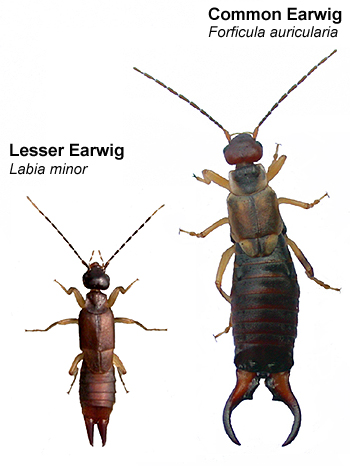

| Common and Lesser Earwigs in Nottinghamshire | ||
| Not many people, even those with
an avid interest in wildlife, will ever nominate the
Earwig as their favourite species. Its an insect that has suffered from parental 'bad press' for centuries, as parents impose their own uneccessary fear of Earwigs on to their own children. Its complete nonsence of course, as the humble Earwig doesn't bite, doesn't sting and certainly wouldn't crawl into your ear to lay its eggs. They are completely harmless. Its amazing that during these times of supposed 'enlightenment' and greater awareness of what is around us, that the 'Earwig in your ear' story is still told and believed to this day. Its only ever adults who help nurture fears and phobias in children about some insects and the humble Earwig has suffered as a result. Earwigs feed on a diet of plant and animal material, a combination that also does them no favours with gardeners, as Earwigs are minor pests of Chrysanthemum and other cut flowers. They rest during the day in crevices, but especially under loose bark, in hollow plant stems and dead flower heads. The Winter is passed as an adult, in similarly dark, dry places. Female Earwigs are extremely maternal and show great parental brood care. They lay a small number of eggs in an underground chamber and protect them during the Winter months. She remains with the nymphs until they become independent from her, when warmer conditions arrive during the Spring. |
 |
| ...... | ||
| Nottinghamshire
species Earwigs belong to the Order Dermaptera and are historically considered to be related to Crickets and Grasshoppers (Order: Orthoptera). There are four species resident in the UK and three species which have only occurred in the UK as 'accidentals' through importation. The UK's four resident, or native Earwigs are listed below.
Of the above species, only Common Earwig and Lesser Earwig have ever been known to occur in Nottinghamshire. Common Earwig is by far the most common and widespread reported species, as it is more obvious and larger than its smaller relative. Lesser Earwig may be equally as common in Nottinghamshire, but just very much under-recorded on account of its small size. The Short-winged or Hop Garden Earwig is confined to south-eastern counties of the UK and is unlikely to ever occur in Nottinghamshire. Lesne’s Earwig is found across most southern counties of the UK, but there are records from as far north as just west of Birmingham and from the Peterborough area. Despite there not being any traceable records from neighbouring Derbyshire, Leicestershire or Lincolnshire, it would not be a total surprise to see Lesne's turn up in south Nottinghamshire. |
||
| INSECTA (Class) - DERMAPTERA (Order) - SPONGIPHORIDAE (Family) - Labia (Genus) | ||
| Lesser
Earwig Labia minor (Linnaeus,
1758) |
||
| Description:
Lesser Earwig can be overlooked and easily
mistaken for a small Rove Beetle (Staphylinidae). It is
considerably smaller than the Common Earwig, covered in a
golden pubescence giving it a matt appearance and
measuring only around 5.0 - 6.0mm in length. The
pubescence wears off with age and is easiest to see along
the rear edges of the abdominal sections (tergites) but a
good photograph or hand lens is really needed to see it.
The colouration (depending on age) is various shades of
rich browns, with the head being darker and the legs a
pale yellow. The 'forceps' are straight. Lesser Earwig females show great parental care of their eggs and young. Breeding occurs all year round, with the development from egg to adult being complete within a few months. Both adults and nymphs will often be found together where there is moisture and a relatively constant, warm temperature. Manure and compost heaps are certainly ideal places. Nottinghamshire distribution: In recent years, we have found it easiest to find in manure heaps (occasionally in large numbers), but have otherwise only seen it on the odd occasion when attracted to MV light traps (Lesser Earwig flies readily). Its present Nottinghamshire distribution is entirely built on on the two methods mentioned and recorder awareness. There is no reason to suspect that it is not found throughout the county and is just as likely in urban areas. |
||
| ...... |
|
|
|||||
| INSECTA (Class) - DERMAPTERA (Order) - FORFICULIDAE (Family) - Forficula (Genus) | ||
| Common
Earwig Forficula auricularia
(Linnaeus, 1758) |
||
| Description:
One of our most familiar insects, which is
fully-winged although they rarely fly. The adults measure
between 10-15mm in length and are found in all habitat
types, they will often turn up indoors and are
essentially nocturnal, hiding away during the daylight
hours. Adults can be found throughout the year and are
generally at peak numbers during the Autumn. Females are
able to produce two broods during the year. Distinctly two-toned in colour, the pronotum, elytra and legs are a pale yellowish and the abdomen a dark chestnut brown. The head is distinctly reddish brown. The 'forceps' are curved in the male and straight in the female. Nottinghamshire distribution: Widespread and very common throughout the whole of the county. It will no doubt be present in every grid square within VC56 (Nottinghamshire). |
||
| ...... |
|
|
|||||